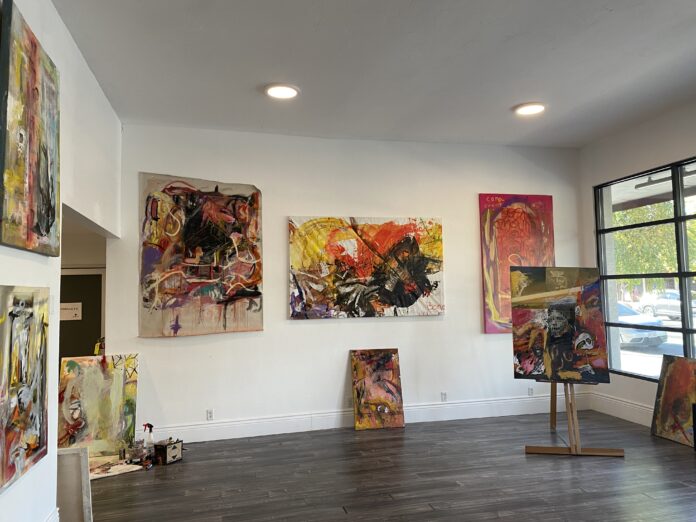
“Meeting all these art people is like meeting the mob,” Brian C. Gibson said as he took a drag of his cigarette. The exhaled smoke blew in the direction of his art gallery at Inside Style on Main Street and Charleston Boulevard.
The residency, titled “Boytoy Summer,” is nearing the end of its run; it is set to close this Wednesday. “Boytoy Summer” is a collection of works created by Gibson under the guidance of prominent local art figure and patron, Brett Wesley.
Over a cup of coffee across the street from the gallery, Gibson took issue with what he deems “spectacles” in the art world. His style is not Meow Wolf-esque, nor does it resemble the colossal, immersive art experiences that attract hour-long lines and require a ticket for entry.
“I just put myself out there,” Gibson said. “I put a sign outside that says ‘Open Gallery’ and when people walk in I go, ‘Hey, how are you doing?’ and then it’s just open. It’s improvisational conversation, or just life. People are coming in and I don’t know who they are, and they don’t know who I am.”
Improvisation sums up Gibson’s creative process, from the ambiguous, ambient music he listens to, and concepts that come alive on his canvases. He deviates from gauging his works and audiences with a fine-tooth comb, and instead allows his abstractism to speak for itself.
“[My art style is] stream of consciousness, automatic writing, improvisational and exploring the subconscious. Very Carl Jung,” Gibson said.
But Gibson was not always able to act on his interest in art, he often felt suppressed by academics in his younger years. When “school didn’t yield any good results,” he found solace in online communities where he could bond with others over guitar-playing and “weird ideas.”
In fact, it was music that first introduced Gibson to the idea of capitalizing on his art. He recalled that initially, he held art shows to raise money for his path in music. His band, Wax Pig Melting, granted Gibson the freedom to experiment with lyricism and poetry, something he continues to fuse into his work today.
Journal entries play a vital role in his innovation, as many of his pieces convey his written thoughts. Gibson labeled his journaling “compulsive” and lightheartedly connected this to his attention deficit disorder.
“I have to take Adderall,” Gibson said. “I do, and it’s helped my life a lot.”
The 33-year-old is an open book about substance dependency, and views his art as a route of recovery. Even in a “scattered” art scene like Las Vegas, he draws from his own experiences in order to connect with others, in conversation and artistically.
“There is a strong undercurrent in Las Vegas, but it’s also smothered by the entertainment and all the new casinos coming in,” the Las Vegas native said about working in the ever-evolving city. “Tourists just go right past [local artists]. We don’t have the licensing or the sheer volume of merchandise that tourists want. How does anything stay here?”
But Gibson is not entirely opposed to tourism. In actuality, he loves tourists.
“You need to integrate them,” Gibson said.
Outside of painting, Gibson dabbles in video and audio expression, he has a podcast and said he also wants to try sculpting. He developed new ways of looking at his art since his debut.
“My style has always been really raw and honest,” Gibson said. “I never had an aim [in the past]. Now, it has an aim to be done correctly. That’s about it. Now I want everything to be cohesive, look good, be framed, stretched and have varnish over it. I want professionalism on the finish of the work.”
Gibson takes inspiration from the quiet moments when his mind is focused solely on art. This is when he is able to put his “improv shoes” on and contrast the figurative and decorative art styles which encompass the local community.
Cecily Brown, a British painter, Andy Heck Boyd, an experimental musical artist and Retna, a contemporary artist, are all figures whom Gibson admires. In particular, Gibson relates to Andy Heck Boyd as a fellow “outside artist.”
An “outside artist” typically has no formal training in art, and did not study it in school. These artists adapt and learn as they go, taking in knowledge whenever possible.
As for what lies ahead, Gibson expects to end up in either Los Angeles, New York or Berlin. At the very least, he wants “a good job helping other people explore art as a form of recovery.”
“That’s what’s in the future for me: Workshops and trying to share what I’ve learned.”
